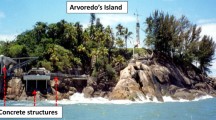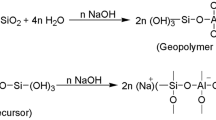Abstract
Alkali in cement is responsible for the Alkali–silica-reaction phenomenon that manifests itself in the form of premature cracking in concrete structures such as bridge decks and concrete pavements. X-ray fluorescence spectroscopy (XRF) is commonly used for cement Alkali quantification but a simpler and faster analytical procedure based on Fourier transform infrared spectroscopy (FTIR) has been expanded for this purpose. An analytical absorption band at 750 cm−1 in the FTIR spectra of cement samples belonging to Alkali solid solution of tricalcium aluminate [C3A(ss)] is used for Alkali quantification. Regression analysis of a plot correlating FTIR absorption band area ratio (750/923 cm−1) to equivalent Alkali Na2O e (Na2O e = % Na2O + 0.658 × % K2O) measured by XRF shows a linear correlation coefficient, R 2, of 0.97. High Alkali cement samples show a higher microstructural disorder coefficient, C d, which is a reactivity criterion introduced by Bachiorrini and co-authors (Proceedings of the seventh international conference on concrete alkali-aggregate reactions‚ 1986) for ASR-susceptible aggregates. Results of this research indicate applicability of FTIR technique to quantitatively predict cement vulnerability to ASR through the \( A_{{750\,{\text{cm}}^{ - 1} }} \) to \( A_{{923\,{\text{cm}}^{ - 1} }} \) band area ratio and the magnitude of the disorder coefficient (C d).





Similar content being viewed by others
References
Folliard KJ, Barborak R, Drimalas T, Du L, Garber S, Ideker J, Ley T, Williams S, Juenger M, Thomas MDA, Fournier B (2006) Project Summary Report 0-4085-S March 2006. http://www.utexas.edu/research/ctr/pdf_reports/0_4085_S.pdf. Viewed 9 Aug 2011
Hassan MY, Abdel-Hakeem N (1989) Study of anhydrous and hydrated Portland cement containing alkali ions by infrared spectroscopy. J Mater Sci Lett 8:578–580
Puertas F, Fernandez-Jimenez A, Blanco-Varela MT (2004) Pore solution in alkali-activated slag cement pastes, relation to the composition and structure of calcium silicate hydrate. Cem Concr Res 34:139–148
Berra M, Mangialardi T, Paolini AE (2005) Alkali–silica reactivity criteria for concrete aggregates. Mater Struct 38:373–380
Baronio G, Berra M, Bachiorrini A, Delmastro A, Montanaro L, Negro A (1986) In: Proceedings of the seventh international conference on concrete alkali-aggregate reactions, Ottawa, pp 309–313
Stoch L, Sroda M (1999) Infrared spectroscopy in the investigation of oxide glasses structure. J Mol Struct 511–512:77–84
Palomo A, Fernandez-Jimenez A, Kovalchuk G, Ordoňez LM, Naranjo MC (2007) Opc–fly ash cementitious systems: study of gel binders produced during alkaline hydration. J Mater Sci 42(9):2958–2966. http://www.springerlink.com/content/jq631288076322ng/fulltext.html
Hughes T, Methven C, Jones T, Pelham S, Fletcher P, Hall C (1995) Determining cement composition by Fourier transform infrared spectroscopy. Adv Cem Based Mater 2:91–104
Tambelli CE, Schneider JF, Hasparyk NP, Monteiro PJM (2006) Study of the structure of alkali–silica reaction gel by high-resolution NMR spectroscopy. J Non Cryst Solids 352:3429–3436
Miller FA, Wilkins CH (1952) Infrared spectra and characteristic frequencies of inorganic ions. Anal Chem 24:1253–1294
Varma SP, Wall CD (1981) A monoclinic tricalcium aluminate (C3A) phase in a commercial Portland cement clinker. Cem Concr Res 11:567–574
Stephan D, Wistuba S (2006) Crystal structure refinement and hydration behaviour of doped tricalcium aluminate. Cem Concr Res 36:2011–2020
Nasrazadani S, Mielke D, Springfield T, Ramasamy N (2009) Texas Transportation Institute 0-5608 final report
Texas Department of Transportation (2009) Tex-317-D. http://ftp.dot.state.tx.us/pub/txdot-info/cst/TMS/300-D_series/pdfs/cem317.pdf. Accessed 13 July 2013
van Eijk RJ, Brouwers HJH (2000) In: WASCON 2000, the 4th international conference on the science and engineering of recycling for environmental protection, Harrogate. http://doc.utwente.nl/21577/1/Conference9.pdf
Item 421 of “Standard specifications for construction and maintenance of highways, streets, and bridges”. ftp.dot.state.tx.us/pub/txdot-info/des/specs/specbook.pdf
Suherman PM, van Riessen A, O’Conner B, Li D, Bolton D, Fairhurst H (2002) Determination of amorphous phase levels in Portland cement clinker. Powder Diffr 17(3):178–185
Arnold T, Rozario-Ranasinghe M, Youtcheff J (2006) Determination of lime in hot-mix asphalt. Transp Res Rec Rep 1962:113–120
Springfield T (2011) Application of FTIR for quantification of alkali in cement. Master Thesis University of North Texas
Acknowledgments
Federal Highways Administration and Texas Department of Transportation supported this project. Authors would like to acknowledge helpful discussions provided by Dr. German Claros of TxDOT. Special thanks to all members of TxDOT oversight research management committee members (RMC1) for their helpful recommendations and guidance. Our appreciations are extended to Ms. Elizabeth Luckefahr and Mr. Clifton Coward for their assistance with XRF measurements.
Author information
Authors and Affiliations
Corresponding author
Rights and permissions
About this article
Cite this article
Nasrazadani, S., Springfield, T. Application of Fourier transform infrared spectroscopy in cement Alkali quantification. Mater Struct 47, 1607–1615 (2014). https://doi.org/10.1617/s11527-013-0140-3
Received:
Accepted:
Published:
Issue Date:
DOI: https://doi.org/10.1617/s11527-013-0140-3




